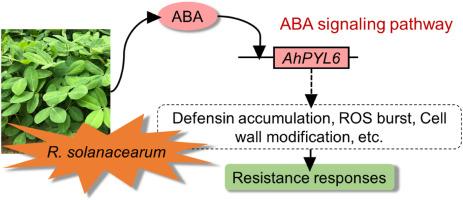Genome-wide characterization of pyrabactin resistance 1-like (PYL) family genes revealed AhPYL6 confer the resistance to Ralstonia solanacearum in peanut
IF 6.1
2区 生物学
Q1 PLANT SCIENCES
引用次数: 0
Abstract
Bacterial wilt (BW) caused by Ralstonia solanacearum severely impacts the yield and quality of peanut (Arachis hypogaea L.), a globally cultivated industrial crop. Despite the abscisic acid (ABA) signaling pathway have been identified as key factors in peanut resistance to BW, the molecular mechanism remains unclear. Through systematic identification, it was discovered that the peanut genome contains 18 ABA receptor pyrabactin resistance 1-like (PYL) family genes, which show conservation with other plant species. Among these PYL genes in peanut (referred to as AhPYL), AhPYL6 and AhPYL16 showed significant up-regulation in response to salicylic acid, jasmonic acid, ABA treatments, and R. solanacearum infection. Subsequently, the full-length AhPYL6 was cloned and functionally characterized. The fusion protein AhPYL6-YFP was predominantly expressed in the cytoplasm and nucleus of tobacco leaves, and overexpression of AhPYL6 notably enhanced resistance against R. solanacearum. Expression analysis revealed that the expression levels defense -related genes including NbNPR1, NbPR2, NbPR3, NbHRS203, NbEFE26, and NbNDR1 were significantly up-regulated by the overexpression of AhPYL6, which suggested that AhPYL6 confers the resistance to R. solanacearum through promoting expression of defense -related genes. These findings highlight the potential roles of PYL ABA receptors in the plant defense response to bacterial pathogens.

对类似吡拉菌素抗性 1 (PYL) 家族基因的全基因组特性分析表明,AhPYL6 能赋予花生对茄尼氏菌 (Ralstonia solanacearum) 的抗性
由 Ralstonia solanacearum 引起的细菌性枯萎病(BW)严重影响了花生(Arachis hypogaea L.)的产量和质量,而花生是一种全球栽培的工业作物。尽管脱落酸(ABA)信号通路已被确定为花生抗BW的关键因素,但其分子机制仍不清楚。通过系统鉴定,发现花生基因组中含有 18 个 ABA 受体抗性 1-like pyrabactin(PYL)家族基因,这些基因与其他植物物种具有相同的保守性。在花生的这些PYL基因(简称为AhPYL)中,AhPYL6和AhPYL16在水杨酸、茉莉酸、ABA处理和茄碱酵母菌感染时表现出显著的上调。随后,全长的 AhPYL6 被克隆出来并进行了功能鉴定。融合蛋白AhPYL6-YFP主要在烟草叶片的细胞质和细胞核中表达,过表达AhPYL6可显著增强对茄碱菌的抗性。表达分析表明,AhPYL6的过表达显著上调了NbNPR1、NbPR2、NbPR3、NbHRS203、NbEFE26和NbNDR1等防御相关基因的表达水平,这表明AhPYL6是通过促进防御相关基因的表达来增强烟草对茄科细菌的抗性的。这些发现凸显了PYL ABA受体在植物对细菌病原体的防御反应中的潜在作用。
本文章由计算机程序翻译,如有差异,请以英文原文为准。
求助全文
约1分钟内获得全文
求助全文
来源期刊
CiteScore
11.10
自引率
3.10%
发文量
410
审稿时长
33 days
期刊介绍:
Plant Physiology and Biochemistry publishes original theoretical, experimental and technical contributions in the various fields of plant physiology (biochemistry, physiology, structure, genetics, plant-microbe interactions, etc.) at diverse levels of integration (molecular, subcellular, cellular, organ, whole plant, environmental). Opinions expressed in the journal are the sole responsibility of the authors and publication does not imply the editors'' agreement.
Manuscripts describing molecular-genetic and/or gene expression data that are not integrated with biochemical analysis and/or actual measurements of plant physiological processes are not suitable for PPB. Also "Omics" studies (transcriptomics, proteomics, metabolomics, etc.) reporting descriptive analysis without an element of functional validation assays, will not be considered. Similarly, applied agronomic or phytochemical studies that generate no new, fundamental insights in plant physiological and/or biochemical processes are not suitable for publication in PPB.
Plant Physiology and Biochemistry publishes several types of articles: Reviews, Papers and Short Papers. Articles for Reviews are either invited by the editor or proposed by the authors for the editor''s prior agreement. Reviews should not exceed 40 typewritten pages and Short Papers no more than approximately 8 typewritten pages. The fundamental character of Plant Physiology and Biochemistry remains that of a journal for original results.

 求助内容:
求助内容: 应助结果提醒方式:
应助结果提醒方式:


